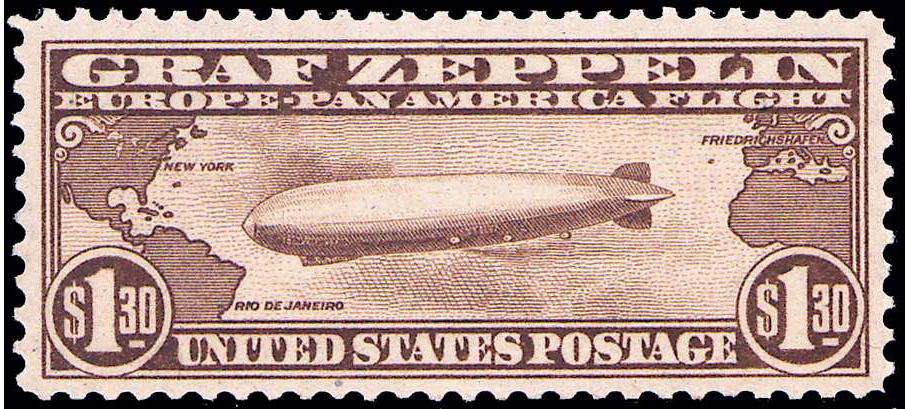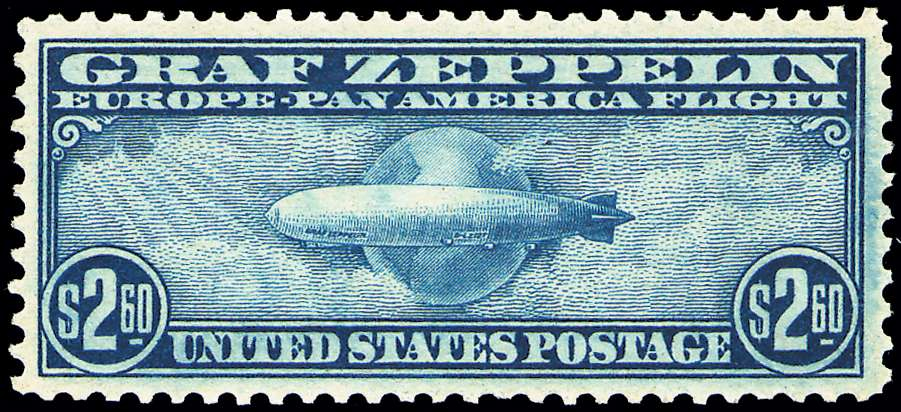back to
U.S. Graf Zeppelin Stamps
Key Set to Every U.S. Airmail Collection (#C13-15)
In 1930, while the country was deep in the Great Depression, flying across countries and oceans in a lighter than air craft was something many dreamed of but few could afford. People from around the globe watched as the Graf Zeppelin, the largest airship ever created, began its globetrotting voyage. Passengers aboard this luxury craft were charged $9,900 for a trip around the world. In today’s dollars that trip would cost $126,000. Even at this exorbitant price, the German Zeppelin Airship Works did not expect to make a profit by selling tickets, as the 775 foot long craft could accommodate only 20 passengers at a time. Where the real money would come from was through the sale of special airmail issues, created by the U.S. Postal Service and other postal administrations around the world. The airship had created astounding publicity, as the crew of its inaugural transatlantic flight in 1928 was welcomed with tickertape parades and a visit with President Coolidge at the White House.
Controversial Agreement with the Graf Zeppelin Company
The Postal Service agreed to produce a set of 3 unique U.S. Graf Zeppelin stamps to commemorate the first transatlantic flight of 1930, even though the U.S. Post Office would receive only 6.5% of the stamp’s denomination for letters that traveled on the Graf Zeppelin. The German Zeppelin Airship Works would enjoy the lion’s share of the profit from each stamp, but only on stamps that actually traveled on their airship. The U.S. Postal Service agreed to issue the U.S. Graf Zeppelin stamps regardless because it was thought that most of the customers would be philatelists looking to add the stamps to their collection, thus retaining all of the revenue for the Post Office. However in the midst of the Great Depression many citizens were wondering how to get enough food on their tables to feed their family, and could not even consider spending the exorbitant 65¢, $1.30 or $2.60 face value for the set of 3 U.S. Graf Zeppelin stamps. By today’s standards, that would have been equal to spending almost $60 dollars for the set of 3 U.S. Graf Zeppelin stamps. This was during a time when bread cost 9¢ a loaf, corn dropped to 8¢ per bushel and people still could not afford to feed their families. The Post Office did not consider this when it announced that 1,000,000 sets of Graf Zeppelin stamps would be issued, and that after 2 months any unsold stamps would be destroyed. Designed to create increased demand for the Zeppelin issues, in all only 227,260 stamps were sold, or 7% of the total created.
Cornerstone for Every Complete U.S. Airmail Collection
Many philatelists of the time turned their back on these issues, citing that the Postal Service was charging too much, and trying to drum up demand by destroying unsold issues. While highly publicized and controversial at the time, in the years since their issue Graf Zeppelin Airmails have become highly sought by collectors. In those days many thought that Zeppelins would become the future of transatlantic travel. Following the tragic explosion aboard the Hindenburg seven years later these giant dirigibles would become the "Titanic" of the skies. View the U.S. Graf Zeppelin stamps that we carry.




